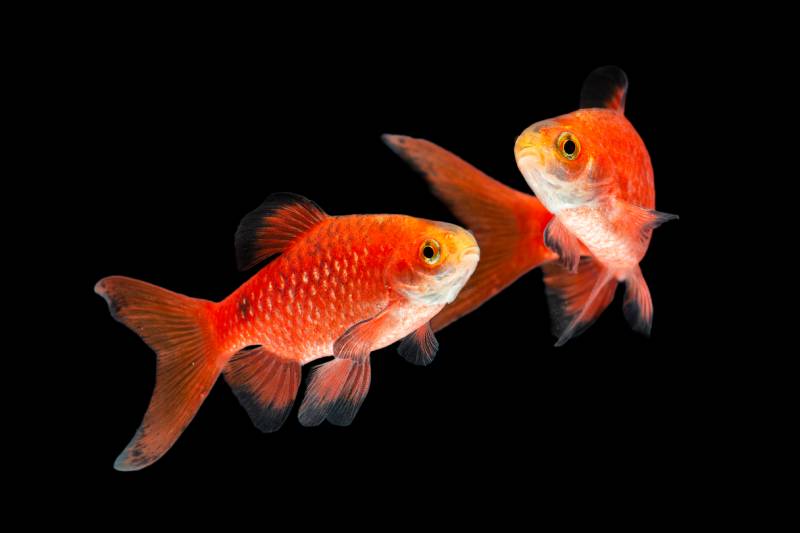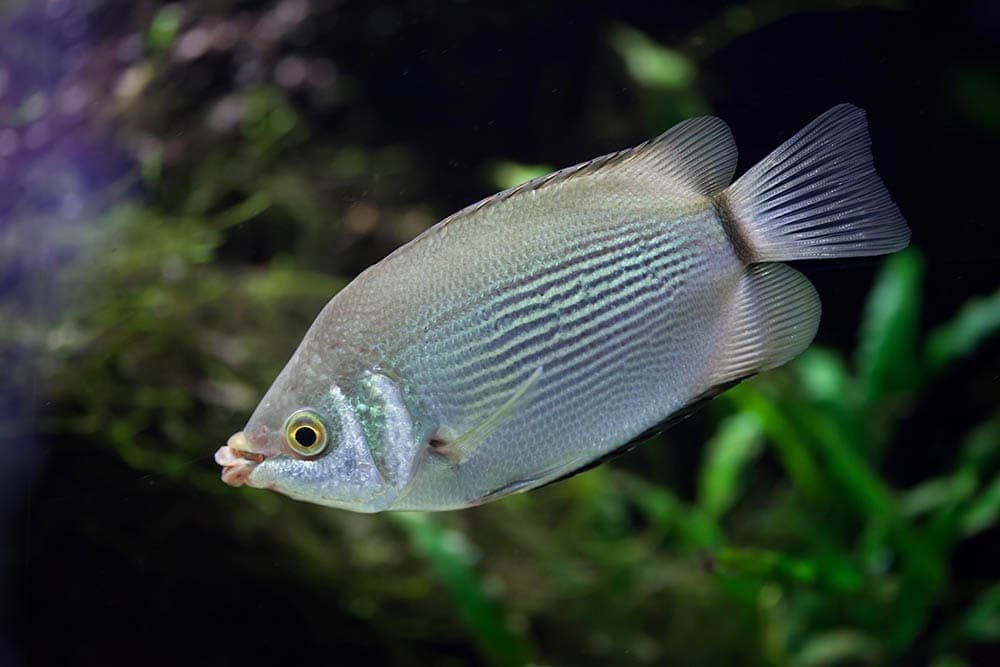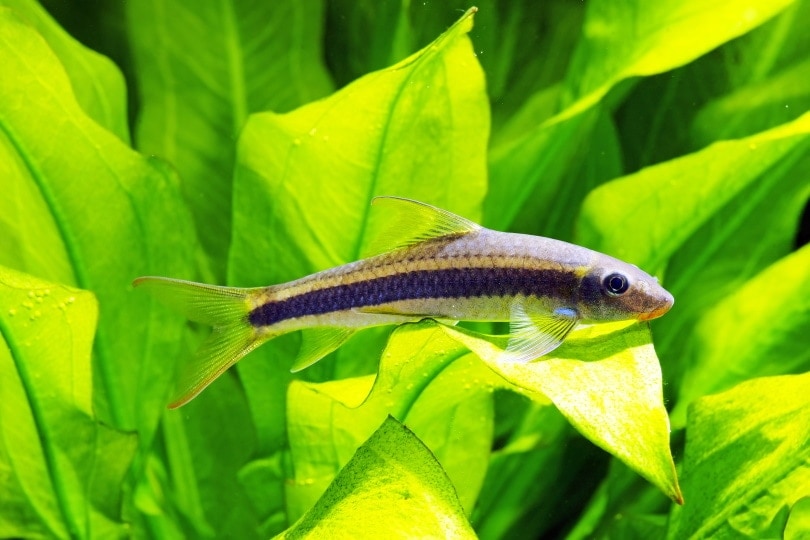Rosy Barb: Pictures, Size, Care, Tank Setup & More
Updated on

The name of the rosy barb may tell you everything you need to know about this fish. Many people consider it a very beautiful species, with the males sporting more colors than the females. They’re also considered hardy and relatively peaceful. These traits make them an excellent choice for a community tank populated with species of a similar temperament. If you’re interested in learning more about the rosy barb before adding them to your tank, you’re in the right place. Keep reading.
Quick Facts About the Rosy Barb
| Species Name: | Pethia conchonius |
| Family: | Cyprinidae |
| Care Level: | Easy |
| Temperature: | 64–72 °F (18–22 °C ) |
| Temperament: | Peaceful |
| Color Form: | Yellow to orange with red coloration, colors bolder when breeding |
| Lifespan: | 5 years (average) |
| Size: | Up to 6 inches (14 centimeters) |
| Diet: | Omnivore |
| Minimum Tank Size: | 30 gallons for a group of five |
| Tank Setup: | Well-planted aquarium with structures for hiding places |
| Compatibility: | Peaceful community fish of like size and temperament |
Rosy Barb Overview

The beauty and hardiness of the rosy barb are their primary selling points. The fish is relatively easy to breed in captivity, which keeps their price affordable. The size of the species makes a large tank necessary to give them enough space to swim freely. That’s especially true since they’re schooling fish. The rosy barb usually isn’t an aggressive species, either.
How Much Do Rosy Barbs Cost?
The rosy barb isn’t an expensive fish and is generally readily available. You can find them sold singly or in small schools. The cost of the former is around $7, although you can get them cheaper if you put them in sets. You can find them online or at brick-and-mortar stores. Make sure your fish comes with a health guarantee to protect your purchase.
Typical Behavior & Temperament
Rosy Barbs live in lakes and streams in Asia, including Bangladesh, India, and Nepal. They have been introduced in Singapore, Puerto Rico, and Mexico. They are schooling fish and prefer this lifestyle. Keeping them in groups can minimize conflicts with other species. Sometimes, they can become nippy, especially in crowded aquariums or when not in a decently sized school. Nevertheless, their care is relatively easy.
Appearance & Varieties
The rosy barbs you purchase will likely be juveniles around an inch long. They have an elongated body, not unlike a perch. They have large dark eyes and prominent caudal, dorsal, and ventral fins the same color as their bodies. There is also a dark spot toward the tail.
The fish gets their name for the vibrant color of the male during their breeding season. The males also have black coloration in their fins, while the females do not.

How to Take Care of Rosy Barb
In the wild, rosy barbs live in different water bodies, which accounts for their hardiness and adaptability. That makes your job easier and means this species is suitable for beginners and experienced enthusiasts. They are subtropical fish, accounting for the preferred lower temperature range. That’s something to keep in mind when setting up your aquarium and choosing tankmates.

Habitat, Tank Conditions & Setup
Space is the top consideration with rosy barbs, considering their adult size and schooling. That means buying a larger tank, making these fish more of an investment than smaller species, like tetras or danios. It’ll cost more to set up your aquarium. However, it also means a more stable environment with a larger volume of water.
Aquarium Size
We recommend at least a 30-gallon tank to house a school of five rosy barbs with their tankmates. An aquarium of this size needs to be further upgraded if you plan on keeping more fish.
Water Quality & Conditions
The subtropical conditions for rosy barbs mean temperatures between 64–72 °F (18–22 °C). The Rosy Barb prefers water with a pH anywhere between 6.0–8.0. Aim for a dH of 5–15 to replicate the soft water chemistry of this species’ native habitats. You’ve probably noticed that the respective ranges are relatively large, reflecting the hardiness of this species.
Tank Setup
The important thing to remember is to balance space and structure. The latter provides cover, which replicates the species’ environment. Despite their size, the rosy barb is still a prey species, making this addition vital. Driftwood and river rocks can fulfill this need. Remember that a large fish needs room to swim. You can place the additions in groups and leave open space between them.
A heater and power filter will ensure the temperature and water quality stay stable and within the species’ preferred range. Remember that pet fish do not appreciate sudden changes in their water parameters, leaving rosy barbs vulnerable to stress whenever this does happen despite their hardiness.
Plants
You should ideally add plants and structures to your tank, like driftwood and river rocks. Live vegetation can satisfy the fishes’ need for plants in their omnivorous diet. Java moss is anecdotally particularly successful with these fish.
Are Rosy Barb Good Tankmates?
Size is the essential thing to keep on the front burner. Big fish eat small fish, not necessarily because the former is aggressive. After all, even parents will consume their eggs and fry if they aren’t removed from the breeding tank. That makes keeping the end game in mind imperative when choosing tankmates. Rosy barbs may be bothersome if you don’t house them in schools. Then, they might go after other fish.
What to Feed Your Rosy Barb
Rosy barbs are omnivores. Thus, they eat both plant and animal-based foods. You should give your fish a mixture of commercial products, like flakes and pellets. Since they are often captive-bred, they readily accept them. You should also offer them freeze-dried and live foods to satisfy their protein needs, such as bloodworms and brine shrimp. Live plants can fulfill other nutritional requirements.
Rosy barbs don’t confine themselves to one area in a tank. They’ll take floating and sinking foods. However, only give them as much as you see them eat to avoid contaminating the water with waste.
Keeping Your Rosy Barb Healthy
The correct tank setup provides an excellent foundation for keeping your rosy barbs healthy. The trick is then to maintain it. Don’t let the species’ hardiness be an excuse to slack on tank maintenance. The usual routine of weekly partial water changes, water testing, and cleaning is still essential for the health of your fish. Consider using timers on your hood to keep conditions stable.
Breeding
Rosy barbs are relatively easy to breed in captivity. We suggest maintaining water temperatures at the higher end of the recommended range. You’ll see behavior changes in the male and physical differences in the female when spawning is imminent. It’s best to use a separate tank for breeding since the parents will eat the eggs and fry. Feed the free-swimming young brine shrimp for a good start in life.
Are Rosy Barbs Suitable for Your Aquarium?
Rosy barbs are popular aquarium fish for a good reason. They are easy to raise and hardy. If you’re looking for a showy and attractive addition to your tank, look no further. A school of these beautiful fish is a showstopper. They are also affordable and relatively peaceful in a community tank with similar size species. What more can you ask for to take your hobby to the next level
Featured Image Credit: Dany Kurniawan, Shutterstock













